The Deadlock of High-end: Illusion & Hyperreality
When does music cease being music? Where is the point that by polishing our stereos brings us to the quality of reproduction that could not be experienced by artists themselves? The age of innocence has passed, we are up into the age of hyperreality and collapsing music experience.
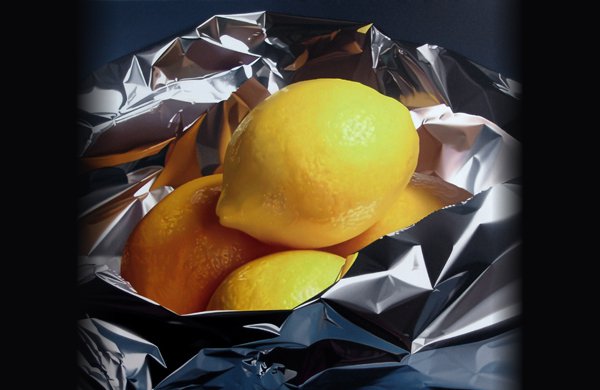
„We are all obsessed with high-fidelity, with the quality of musical reproduction. At the consoles of our stereos, armed with our tuners, amplifiers and speakers, we mix, adjust settings, multiply tracks in pursuit of a flawless sound. Is this still musíc? Where is the high fidelity threshold beyond which music dissapears as such? It does not disappear for lack of music but because it passes this limit point; it disappears into the perfection of its materiality, into its own special effect.”
Jean Baudrillard, The Illusion of The End
Does the hyperrealism kill music?
In the last few months I have had the opportunity to audition some very expensive and reputable highend audio systems, especially speakers. I was surprised at how, with the rising price tags and technological advancements of loudspeakers, the sound departs from musicality and fidelity or both. It would be logical to experience an opposite effect but that was not the case here. For sure there are big names in industry that continue removing haze to unveil what was hidden in recordings without an adverse impact on enjoyment (like TAD, Bowers & Wilkins, Dynaudio, ATC or Harbeth, to name a few) and there are others that put musicality first (Sonus Faber, Duevel and Usher being typical representatives), but there is quickly expanding number of the brands that seem to get lost in their own perfectionism and let the music evaporate in favor of overpolished hypersound.
So, here comes the question: what is the benchmark, the standard by which we should assess realism of a music reproduction? The answer is seemingly pretty straightforward – it is a live performance, isn´t it? The other question arises immediately: what is a live performance?
THE ILLUSION OF A LIVE PERFORMANCE
Please stop reading for a moment and ask yourself: when it was the last time I attended a live performance that can be taken as a benchmark to evaluate my home stereo experience? On the opportunity of Audium Comp 5 compact floorstander in June 2010 Peter Wolf contemplated a bit on this topic:
„We can successfully discuss fidelity if a live unamplified music like classic, folk, jazz or country are considered a standard for comparison. For example, if you ever had an opportunity to compare a live violin with how it was reproduced through your speakers, it was probably the defining moment that made you start saving for better speakers to close the immense sonic gap that you experienced. With unamplified live instruments the benchmark is set.
On the opposite, when someone benchmarks against a live rock or pop music performance, he fools himself. The phrases kind of “I heard it exactly like at the live performance” are invalid here unless you refer to loudness level or emotional excitement. There is nothing that could be discussed in terms of fidelity.
Recently, I have read the following online post: “The live rock concerts ae the truth. What you can hear at home is just what sound engineers had created”. Essentially it is a correct assumption - the problem is that what you could experience live is what sound engineers had created too. The reality and the truth are very relative and volatile in a sense. For example, in the course of two years I attended five times Bruce Springsteen’s shows and there were no two ‘sounds’ alike. I am not able to decide which of the truths was the most truthful.“
Steve Hoffman, Audio Fidelity, DCC and Analogue Productions mastering guru highlighted at one opportunity:
„I highly recommend visiting unamplified live shows, especially jazz or blues. The problem is that they are getting very rare – all concerts are miked and amplified through PA systems. Such sound is not anything you should compare your sound to.“
Unless there is no electricity onstage you can never be sure of what you listen to. Soundstaging? Come on! Heighs? You mean those horn colored? Lows? Is there anything apart from sound pressure? Up to 90% of information relies on visual clues. With your eyes shut the music mostly loses its sonic perfection no matter how entertaining it is. I bet that you’d rather not have such realism at your home stereo.
Stereophile magazine conducted a survey few years ago with a shocking result: one out of three readers had never been to a live performance. This creates a problem, argues John Atkinson, as people who only experience reproduced music are educated into a different set of expectations concerning sound from people who regularly attend live concerts.
THE ILLUSION OF FIDELITY
Painters and sculptors are adored for their view of reality – we call it artistic licence. Even a photographer, that is is principle just documenting real things somehow affects the snapshot with the help of composition, settings or further post-production.
Let’s take an example. I believe you know exactly how a lemon looks like. So, how does it look like?
It could be like the one that was oil-painted by Phillipinian Faith Te:
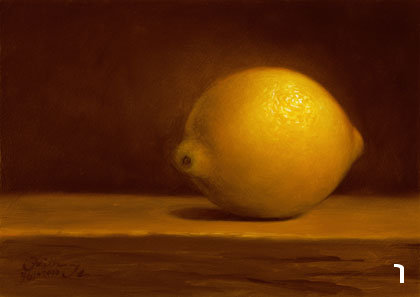
The painting employs soft light and subtle grades of light and shade and that all makes the picture radiate warmth and comfort. Note how schematic is the table, yet there is no doubt it is a wooden table, a heavy one. Though not explicitly expressed, there are many clues that help your eye and brain completes the picture.
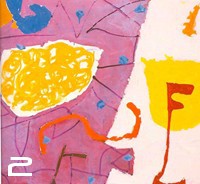
The next painting is from expressionist Patrick Heron. Looks like a scrapbook assembly, it is very graphic, works only with two dimensions and exhibits no depth. If I did not tell you there is a lemon you would not find it. Yet, due to clever use of turquoise elements the painitng successfully builds a tension and fills a room with energy.
Perhaps you prefer the robust brush strokes of an artist that calls himself RoKo? The painting is very dynamic; the light borders dazzling white and contrasts are created through partly reflective and partly absorptive background – it is difficult to say where the lemon rests, yet this unreal thing is perfectly normal in the context of the painting.
On contrast, the reality is very dry:

The snapshot without any touch up is hardly interesting at all. I guess that none of you would pay for it and none of you would put it on a wall at home. Still, the fidelity of this picture is very high, much higher than with the other examples. I hope that by now it is clear that it is not enough to re-live the reality – we need certain arrangements, interpretation and manipulation. Just like in music.
What about this reality?
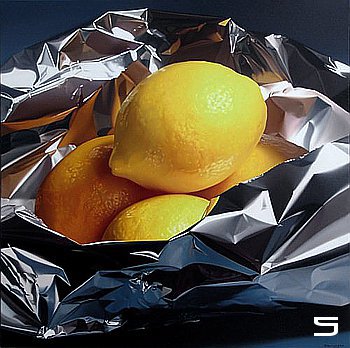
The depth of focus is uncertain, the reflective aluminum foil is just perfect as are the lemons. The picture is well composed, another fine example of photography. Yet, it is not a snapshot. The painting was made by Spanish hyperrealistic painter Pedro Campos who paints realities that are bigger than life.
There is no sense in asking which of the shown pictures you prefer. The level of fidelity is secondary – in fact no one cares. All of them are real for their creators and for those with the same optics. Any of the interpretations is sufficiently HiFi.
The hook is that we all strive for the ultimate reality, like it was shown on the Fig.4, and only later we find such reality totally unacceptable and unsatisfying. In the last two or three years, with the technological advancements, the highend audio moved from the artistic licence to hyperrealism. It reproduces the things that never happened.
Without even noticing it we have passed through the age of the ‘artistic fidelity’ when the music was transcripted through the eyes of an artist, a loudspeaker for instance. Now we listen through magnifying lenses that hyperfocus on tiny details to leave the wholeness unnoticed. We are overwhelmed by huge amount of information at a fraction of time and at full force. Is it still music or just sonic exhibition?
THE ILLUSION OF THE HEARD
The solution to the problem is simple: you have to realize what your preferences are, what your benchmark is and to what extent you need the reproduced music to match the benchmark. Tam Henderson of Reference Recording made the following remark: „A listening public has grown up primarily listening to mult-imiked, studio-type recordings. Talking about live concerts, all you can really speak about is classical music – that‘s now the only unamplified sound you’ll ever hear.”
Not always an audio afficionado wants to measure against live classical music – simply for he or she does not listen to it. In that case the fidelity is a pure subject of personal preferences and there is nothing like universal truth, similarly like there is no universal choice from the lemon pictures.
To set ourselves free it is inevitable for us to accept certain uncomfortable facts. Let mastering guru Doug Sax (Mastering Lab) speak:
Take a string quartet. You’ve got two violins, cello, and viola facing each other. If the room has any size and you back off to the fourth row, you’ll be surprised how small the string quartet is. If you sat in the 15th row and shut your eyes, it would sound like mono. Now, you come up and mike them. You put the violin over here and the cello here, a couple of mics, nothing esoteric. You take this home where you’ll be 10’from the speakers and the violin now goes way over here and the cello goes way over there and it sounds fantastic. But does it sound the way the string quartet did when you were in even a good seat in the audience? Not remotely. And if you made a recording that conveyed the true size of it, even at 20’out of your speakers, nobody would like it.
In fact, when you put an orchestra, which is in reality 60‘ across, it does not sound any bigger than a string quartet. And they want it live so they record it in a barn and here youget these bigger-than-life instruments with five seconds of decay and people sit at home and say “Here is a string quartet”.
Obviously, the measure is not just the sound of an instrument, its timbre, harmonic envelope or spectrum. The realism also considers proportions, the size of the instrument and its size in the context of the size of an orchestra, left to right and front to back spatial perspective and many other things. In such attributes the high end audio is already far ahead of reality – sitting in a listening chair gives much more microscopic insight into what happens on a stage.
You’re used to having the small instrument sound enormous and used to having the enormous instrument, the orchestra, sound small. Because you have a speaker that is much bigger than a guitar and much smaller than a symphony orchestra, you’ve got problems.
 This is indeed a paradox. Whatever fix you apply, you end up unsatisifed. Have you ever tried to listen to a piano (I mean at a live unamplified performance) with your eyes closed? What was its size? Despite having the best seat in an auditorium you hardly experienced the full-sized proportions, it was more like a one meter wide instrument. And if the pianist’s fingers travel the keyboard, were you able to distinguish it spatially? Not a chance, any Steinway and any Diana Krall are like a point source from 20 meters. Despite it, we demand to hear such information from our stereos, we demand the piano to be realistically sized, we demand to actually be a pianist, not a listener.
This is indeed a paradox. Whatever fix you apply, you end up unsatisifed. Have you ever tried to listen to a piano (I mean at a live unamplified performance) with your eyes closed? What was its size? Despite having the best seat in an auditorium you hardly experienced the full-sized proportions, it was more like a one meter wide instrument. And if the pianist’s fingers travel the keyboard, were you able to distinguish it spatially? Not a chance, any Steinway and any Diana Krall are like a point source from 20 meters. Despite it, we demand to hear such information from our stereos, we demand the piano to be realistically sized, we demand to actually be a pianist, not a listener.
Guitar Pleasures is a collection of Spanish and Italian pieces for acoustic guitar, that was released on Sheffield Lab label (SLS 504). Michael Newman was recorded on a two-track tape recorder with a minimalist miking technique. Doug Sax made an interesting experiment behind the recording session:
I put him [Michael Newman] in the Mastering Lab between my speakers just the way he would image, turned all the equipment off and let him play. Do you realize how quiet a classical guitar is? It’s a delicate, gorgeous, quiet instrument. It’s a big problem because I can play it out of the speakers 20dB louder than he is. It sounds wonderful. Loud clarity.
But you go in front of the Harry James Band and that band is 20dB louder than my speakers can play. You are afraid to get close to the band with mics!
At home we replay both performances at the same volume setting so it is natural they as unreal as they get. This is not a fault of a listener, neither it is a fault of components. The problem is in unrealistic expectations that were based on a wish that could not be fulfilled. As I outlined already, it is a listener responsibility to define the level of reality that he or she prefer to experience, and if the goal is behind the natural fidelity, hyperrealistic, it is solely his or her choice.
THE ILLUSION OF THE ORIGINAL
If we are not able to make the direct comparison between the live and the reproduced sound due to the facts that I described earlier or due to the impossibility to simulate the recording set-up, what else can we take as the ultimate fidelity?
Original master tapes may be among the possible options. A master is a tape, that is something recorded, something that does not require presence of an artist – can the master tape substitute the benchmark we are looking for? Can we replay the CD and hear the same like the engineer that made the tapes or listened to them in a control room? Is there anything like the master-tape-fidelity?
Highly unlikely. Jonathan Valin discussed this for UltraHighEndReview online magazine: First, we don’t have access to the master tape. At best we have a source which is several generations removed from the master tape [...]. Each step away from the master tape changes the sound in subtle ways. Even if we had the master tape, we would not know what it actually sounds like – it sounds exactly like the system it is replayed on.
Seems that there is no choice and we have to continue referring to an abstraction, a sound that we feel is truthful. By realizing this the level of the tolerance of the systems of the others should raise inevitably. Why not allow a certain dose of the artistic licence to enter our homes and match the sound with our expectations, sonic and visual? For sure it requires at least minimum idea of how live instruments sound and also soundproofed ears against those who try to manipulate with you.
The components that replay flat recordings with astonishing dynamics, the components that throw spot lights on music, the overpolished hyperdetailed sound, and missing substance, the real flesh of music – this is the result of seeking more an more information on account of the irreversible collapse of natural entertainment.
The main issue is the way how listeners are manipulated by producers, recording companies and distribution channels. Step by step the hyperrealism replaces realism. It starts with overcompression of recordings (check our articles Road To Hell and The Magical Fours) and continues with audio manufacturers employing different techniques to get our attention. One of the examples is the return of the voicing that was used in 80’s – flat response with its bottom and top shelved up – that brings out details and air as well as pumps up the bass that is missing on recordings.
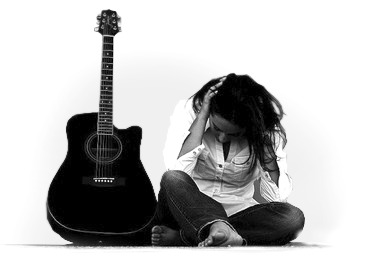
THE ILLUSION OF THE END
The quoation that was used at the beginning of this essay originates from the book The Illusion of The End (Stanford University Press, 1994) by the late French postmodernist and sociologist Jean Baudrillard.
One of the possible hypothesis about which Baudrillard argues in his book is that hyperdensity in city life, commodities and messages leads to deceleration of life to the extend, that new events continually cancel out previous events, therefore life becomes imploded and meaningless. Music becomes so perfected in attemp to reproduce it that it becomes something other than music. It reaches the point of ultimate perfection beyond which it becomes only an illusion or a simulation.
“Beyond this point, nothing is true. It is for this reason that the petite musique of history vanishes into the microscopics or the stereophonics of news.”
The critical thing is to identify the vanishing point. The history (and music) was always subjected to a certain degree of stimulation, however, what happens now is more hyper and accelerated, more artificial, more detached from real life. Time is linear, it flows, it exhibits natural delays, gaps, silences...as they are in music.
Today’s obsession with real time and online events null the natural flow – the news are not spread slowly, they are just delivered at the time it occurs, sometimes even earlier. The streamlining of music becomes an immediate enjoyment – it is virtually a ‘click away’, requires no preparation, can be stopped anytime, there is no physical obligation with it (like going to a live performance, owning a CD or a record). And there is abundance of it. There is no more a glory or passion that surrounds the event. Collecting music becomes senseless, playback requires overstimulation to impress a listener.
One of the logical outcomes is escaping to the past – like the resurrection of vinyl. Unlike digital media the vinyl is less prone to compression and loudness war and helps maintain rituals. To enjoy an LP requires preparation, cleaning, setting up, care, attention... anything that people missed with CD format. And in today’s world of streaming and non-physical formats it is even more important as a listener only owns data or access to data and lacks everything that makes the listening to music an event, there is no aura surrounding the act of the listening.
Steve Guttenberg in Sterophile‘s September 2012 issue explains: „...A hi-rez file of a new recording can't match the bloody realism of a 1960 RCA Living Stereo LP played through a well-set-up turntable, 1980s-era electronics, and a pair of Quad ESL or Klipschorn speakers.
We must have missed some essential aspects of sound reproduction. I have no idea what those aspects might be, but there has to be more to the pursuit of ultimate fidelity than eliminating or reducing imperfections. We need to learn more about capturing and reproducing the gestalt of music. Analog may be far from perfect, but it still seems to convey more of that hard-to-define stuff that brings recorded music to life.“
The high-end audio deadlock is thus only partly caused by technologies – it is also the spirit of the age and the society seeing no other alternative. Even if we can hear more it is not necessary. I’d rather recommend to slow down and buy a ticket for a jazz trio, reformat your hard discs and start listening to real music. Automatically you will learn what’s real and what’s not.
Audiodrom © 2013 MJ-PW-TR




